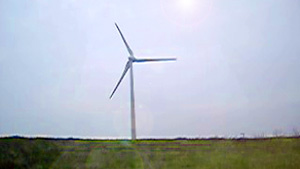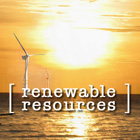 |
| Wind turbines represent a highly efficient means of collecting energy from the natural environment, with a relatively small ecological footprint, if built on ecologically optimal sites. |
|
|
|
'THE WIND RUSH IS ON' IN TEXAS
TEXAS TO BUILD 500 OFFSHORE WIND TURBINES, LARGEST OFFSHORE WIND FARM IN U.S.
15 May 2006
State authorities in Texas have announced plans to build the nation's largest offshore wind farm. The facility would be built about 10 miles off Padre Island in the Gulf of Mexico and would consist of 500 wind-harvesting turbines, 400 feet in height.
The program is part of a recent upsurge in demand across the state of Texas for renewable energy resources. Various energy utilities that had chosen to offer "green" energy programs, initially at a nominal premium, found that rising costs of fossil-fuel-based energy, from natural gas or petroleum, coupled with concerns about dependence on foreign powers, led to a spike in demand for green energy.
As wind energy represents the forward edge of a still-developing renewable-energy economy, its costs have fallen in recent years, and are more stable than those of conventional carbon-based "fossil" fuels, as the supply is not as easily cut off and there are no refining processes or pipeline infrastructure which might obstruct delivery of electricity to the consumer.
Studies sponsored by the Pentagon in the early 1990s, with revised statistics to account for state of the art technology available today, show that the states of North Dakota, Kansas and Texas, together have enough harnessable wind energy to power the entire US economy. As key components of the necessary infrastructure become more affordable and begin coming online, wind energy is looking to be a more and more attractive option for businesses, individual and municipalities, seeking to curb the risk of inflated prices and/or market volatility.
The 500 turbines of the Padre Island offshore facility would produce an estimated 500 megawatts of electricity, enough to power an estimated 125,000 homes. The project would cost between $1 billion and $2 billion, and is expected to be completed within 5 years.
Texas Land Commissioner Jerry Patterson is quoted by the Associated Press as saying "The wind rush is on... we want to be number 1..." His agency seeks to attract investment and to draw on the resources of companies that build the turbines and the state of the art blades that will allow the facility to harvest clean, affordable energy from the wind.
Known as an oil state, and heavily integrated into the fossil-fuel economy of the United States and of international markets, Texas now appears to be taking a chance on one of the most vital growth areas of the energy sector.
But, the project is not without controversy. Environmentalists have protested that the immense windmills could harm rare birds migrating through the area. The Lower Laguna Madre Foundation, named for the body of water between mainland Texas and Padre Island, sees the spot as a particularly poor choice, warning of the potential damage to migratory species.
The Sierra Club has said it supports wind energy as an environmentally sound form of energy production and hopes to work with industry to help reduce the threat of mortality to animal species. Land Commissioner Patterson admits "mortality" is a concern, but asserts the project can be managed in a way that minimizes the threat. [s]

BACKGROUND:
WIND ENERGY DEMAND BOOMING
COST DROPPING BELOW CONVENTIONAL SOURCES MARKS KEY MILESTONE IN U.S. SHIFT TO RENEWABLE ENERGY
22 March 2006 :: Lester R. Brown
When Austin Energy, the publicly owned utility in Austin, Texas, launched its GreenChoice program in 2000, customers opting for green electricity paid a premium. During the fall of 2005, climbing natural gas prices pulled conventional electricity costs above those of wind-generated electricity, the source of most green power. This crossing of the cost lines in Austin and several other communities is a milestone in the U.S. shift to a renewable energy economy. [Full Story]
GREEN LIGHT FOR RENEWABLE FUELS
NEW TECHNOLOGY MAKES SOLAR END-USER FRIENDLY
15 December 2005
Renewable fuels have enjoyed a lot of attention in recent months, in a market driven by escalating oil costs, strained fuel stocks, worsening environmental degradation, and promises by the G8 to reduce carbon emissions. Revelations about the vulnerabilities inherent in the fossil fuel infrastructure, together with new technological advances in wind- and solar-based power generation mean renewables are now directly competitive with traditional fuel sources. [Full Story]
WIND POWER SET TO BECOME WORLD'S LEADING ENERGY SOURCE
Lester R. Brown :: 25 June 2003
In 1991, a national wind resource inventory taken by the U.S. Department of Energy startled the world when it reported that the three most wind-rich
states —North Dakota, Kansas, and Texas— had enough harnessable wind energy to satisfy national electricity needs. Now a new study by a team of
engineers at Stanford reports that the wind energy potential is actually substantially greater than that estimated in 1991. [Full Story]
|
|
ESTALLA LA DEMANDA POR LA ENERGÍA EÓLICA
PRECIOS MÁS BAJOS QUE POR FUENTES TRADICIONALES AYUDAN A ADOPTAR LA ENERGÍA RENOVABLE
22 marzo 2006 :: Lester R. Brown
Cuando Austin Energy, agencia pública de la ciudad de Austin, Texas, lanzó su campaña GreenChoice en el año 2000, el cliente que quería adoptar fuentes energéticas "verdes" tenía que pagar más. Durante el otoño, la persistente subida de los precios por el gas natural hizo que superaran los precios de la energía eólica, un momento clave para el proceso de mudar economía energética del país hacia las fuentes renovables. [Texto completo]
WHY WIND IS SMARTER
21 November 2005
Wind energy offers something no carbon-based fuel can offer: zero emissions, zero cleanup, local control and reasonable local supply everywhere on Earth, and it is 100% non-climate disruptive and essentially infinitely renewable. In fact, the overall global wind resource far exceeds our capacity even to harness or to use it. As of 2003, Pentagon-commissioned research had found that just 3 wind-rich midwestern states possess sufficient wind resources to power the entire US economy with existing wind-turbine technology. [Full Story]
LA ENERGÍA EÓLICA SERÁ EL PRIMER RECURSO ENÉRGICO MUNDIAL
Lester R. Brown :: 25 junio 2003
En 1991, un estudio del Departamento de Energía de Estados Unidos para medir los recursos eólicos nacionales sorprendió al mundo cuando demostró que los tres estados más ricos en viento —North Dakota, Kansas y Texas— poseían un recurso bastante como para satisfacer la demanda nacional para electricidad. Ahora un estudio nuevo, hecho por un equipo de ingenieros de Stanford, reporta que la energía eólica potencial supera por mucho los cálculos de 1991. [Texto completo]
|









